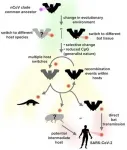(Press-News.org) MRI scanning can more precisely define and detect head, neck, thoracic, abdominal and spinal malformations in unborn babies, finds a large multidisciplinary study led by King's College London with Evelina London Children's Hospital, Great Ormond Street Hospital and UCL.
In the study, published today in Lancet Child and Adolescent Health, the team of researchers and clinicians demonstrate the ways that MRI scanning can show malformations in great detail, including their effect on surrounding structures. Importantly, they note that MRI is a very safe procedure for pregnant women and their babies.
They say the work is invaluable both to clinicians caring for babies before they are born and for teams planning care of the baby after delivery.
Recent research has concentrated on correcting for fetal movement in fetal brain MRI and, more recently, for imaging the fetal heart. However, there is an increasing demand to assess the entire fetus with MRI and research from King's College London School of Biomedical Engineering & Imaging Sciences at Evelina London Children's Hospital, have recently been able to develop a post-acquisition pipeline to motion correct and volume reconstruct images of the whole fetal body.
Lead researcher, Professor Mary Rutherford, from the School of Biomedical Engineering & Imaging Sciences said ultrasound remains the gold standard for fetal screening and indeed is complementary to these optimised MRI approaches for evaluating abnormalities of the fetal body.
"Until now, ultrasound has been the modality of choice to diagnose those anomalies. However, sometimes the ability of ultrasound to define the most detailed anatomy is limited. MRI scanning offers the potential to more precisely define malformations that could help support clinicians in their planning of care and counselling of parents".
MRI is commonly used in the classification of fetal brain anomalies. Although its use in fetal body anomalies is less widely adopted, advances have led to the validation of its role in the antenatal investigation of several conditions including the investigation of fetuses with spina bifida: imaging of the fetal brain along with the spinal cord is an important factor in evaluating which patients could benefit from fetal surgery.
For fetal neck masses, MRI provides a clear advantage over conventional ultrasound for assessing tumour extension and giving a 3D visualisation of the tumour's relation to the airway.
MRI may also be better than ultrasound for distinguishing between normal and abnormal lung tissue, and in making other diagnoses such as diaphragmatic hernia--particularly in late gestation, when doing so with ultrasound is challenging.
New approaches to imaging the fetal body with MRI allows both motion correction of the fetal images and volume reconstructions of body organs and defects. Researchers say this improves visualisation and therefore detection and characterisation of abnormalities.
The project brought together surgeons, fetal medicine specialists, radiologists and physicists to review the use of magnetic resonance imaging to investigate conditions in the unborn baby; this approach has already been integrated into clinical practice at Evelina London, which is part of Guy's and St Thomas' NHS Foundation Trust. Videos and images are also available for viewing.
Ongoing work is focused on a fully automated process suitable for clinical translation and wider dissemination into clinical practice.
INFORMATION:
The Affordable Care Act (ACA) dramatically increased children's preventive healthcare while reducing out-of-pocket costs, according to a new Boston University School of Public Health (BUSPH) study.
Published in JAMA Network Open, the study found that checkups with out-of-pocket costs dropped from 54.2% of visits in 2010 (the year the ACA passed) to 14.5% in 2018.
"This is a great feather in the cap of the ACA, even though there is still some work to do," says study lead author Dr. Paul Shafer, assistant professor of health law, policy & management at BUSPH.
"We found ...
MIAMI--A new study lead by scientists at the University of Miami (UM) Rosenstiel School of Marine and Atmospheric Science demonstrates that under realistic environmental conditions oil drifting in the ocean after the DWH oil spill photooxidized into persistent compounds within hours to days, instead over long periods of time as was thought during the 2010 Deepwater Horizon oil spill. This is the first model results to support the new paradigm of photooxidation that emerged from laboratory research.
After an oil spill, oil droplets on the ocean surface ...
Cancer cells can dodge chemotherapy by entering a state that bears similarity to certain kinds of senescence, a type of "active hibernation" that enables them to weather the stress induced by aggressive treatments aimed at destroying them, according to a new study by scientists at Weill Cornell Medicine. These findings have implications for developing new drug combinations that could block senescence and make chemotherapy more effective.
In a study published Jan. 26 in Cancer Discovery, a journal of the American Association for Cancer Research, the investigators reported that this biologic process could help explain why cancers so often recur after treatment. The research was done in both organoids and mouse models ...
A study of the relationship between temperature and yields of various rice varieties, based on 50 years of weather and rice-yield data from farms in the Philippines, suggests that warming temperatures negatively affect rice yields.
Recent varieties of rice, bred for environmental stresses like heat, showed better yields than both traditional rice varieties and modern varieties of rice that were not specifically bred to withstand warmer temperatures. But the study found that warming adversely affected crop yields even for those varieties best suited to the heat. Overall, the advantage of varieties bred to withstand increased heat was too small to be statistically significant.
One of ...
Intake of a high-fat diet leads to an increased risk for obesity, type 2 diabetes, cardiovascular diseases and fatty liver. A study in mice from Karolinska Institutet in Sweden shows that it is possible to eliminate the deleterious effects of a high-fat diet by lowering the levels of apolipoprotein CIII (apoCIII), a key regulator of lipid metabolism. The study is published in the journal Science Advances.
Increased levels of the protein apoCIII are related to cardiovascular diseases, insulin resistance and type 2 diabetes. Researchers at the Rolf Luft Research ...
New research led by the University of Cambridge has found rare evidence - preserved in the chemistry of ancient rocks from Greenland - which tells of a time when Earth was almost entirely molten.
The study, published in the journal Science Advances, yields information on a important period in our planet's formation, when a deep sea of incandescent magma stretched across Earth's surface and extended hundreds of kilometres into its interior.
It is the gradual cooling and crystallisation of this 'magma ocean' that set the chemistry of Earth's interior - a defining stage in the assembly of our planet's structure and the formation of our early atmosphere.
Scientists know that catastrophic impacts during the formation of the Earth and Moon would have generated ...
As the driver of global atmospheric and ocean circulation, the tropics play a central role in understanding past and future climate change. Both global climate simulations and worldwide ocean temperature reconstructions indicate that the cooling in the tropics during the last cold period, which began about 115,000 years ago, was much weaker than in the temperate zone and the polar regions. The extent to which this general statement also applies to the tropical high mountains of Eastern Africa and elsewhere is, however, doubted on the basis of palaeoclimatic, geological and ecological studies at high elevations.
A research team led by Alexander Groos, Heinz Veit (both from the Institute of Geography) and Naki Akçar (Institute of Geological Sciences) at the University ...
How much did SARS-CoV-2 need to change in order to adapt to its new human host? In a research article published in the open access journal PLOS Biology Oscar MacLean, Spyros Lytras at the University of Glasgow, and colleagues, show that since December 2019 and for the first 11 months of the SARS-CoV-2 pandemic there has been very little 'important' genetic change observed in the hundreds of thousands of sequenced virus genomes.
The study is a collaboration between researchers in the UK, US and Belgium. The lead authors Prof David L Robertson (at the MRC-University of Glasgow Centre for Virus Research, Scotland) ...
Informing how COVID-19 response plans may incorporate digital contact tracing, a model of COVID-19 spread within a simulated French population found that if about 20% of the population adopted a contact tracing app on their smartphones, an outbreak could be reduced by about 35%. If more than 30% of the population adopted the app, the epidemic could be suppressed to manageable levels. Jesús Moreno López and colleagues note that the effectiveness of digital contact tracing would depend on a given population's level of immunity to the virus; the intervention alone would be unable to suppress a COVID-19 epidemic where transmission - and especially asymptomatic transmission - remains high. While many countries have implemented ...
DURHAM, N.C. -- If you binged on high-calorie snacks and then spent the winter crashed on the couch in a months-long food coma, you'd likely wake up worse for wear. Unless you happen to be a fat-tailed dwarf lemur.
This squirrel-sized primate lives in the forests of Madagascar, where it spends up to seven months each year mostly motionless and chilling, using the minimum energy necessary to withstand the winter. While zonked, it lives off of fat stored in its tail.
Animals that hibernate in the wild rarely do so in zoos and sanctuaries, with their climate controls and ...




